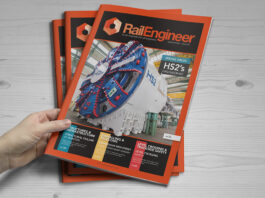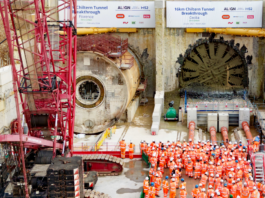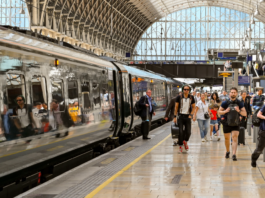A relatively straight and high-speed route, the East Coast main line from London to Edinburgh has been a target for electrification several times over the years. The UK Government’s Weir report in the 1930s had considered it and, in the 1950s, British Railways ranked it in parallel with the West Coast main line electrification intention.
Politics seemed to dog the aspiration with the cessation of development progress in the early 1960s while the West Coast moved forward, albeit not without “pauses”. Instead, the East Coast moved forward with fairly adventurous diesel schemes – the legendary English Electric Deltic locomotives moving in to displace steam and then the arrival of the world beating High Speed Train in the 1970s.
By the mid-1970s the line had been electrified, under the “Great Northern” banner, as far as Hitchin – the wires then heading east to Royston. Although the fast lines were wired to Hitchin, no further progress was made.
In 1979, the British Railways Board launched a comprehensive proposal for the electrification of the bulk of the British railway system and an obvious target to start was the East Coast main line (ECML). The Board duly produced a submission for electrification to Edinburgh that was passed to the Department of Transport, but this was returned with a simple reaction: NO!
British Rail could see the advantage of retaining the expertise that existed in the design and construction organisations at the time and, in fact, financed the installation of OLE foundations north from Hitchin while it tried to convince the politicians that continuation was in the country’s best interest. Sadly, this fell on deaf ears and the line continued for some time as a diesel railway, albeit with the High Speed Train as its core product.
Happily, however, after much effort by BR, electrification was finally authorised in the 1980s, after much value engineering and sharp concentration on content and specification, producing the electrified East Coast main line we see today, with push-pull Class 91 and Mark 4 carriages as the core passenger product. Donald Heath describes how the electrification work was carried out in his excellent companion article in this issue.
IEP is coming
The Intercity Express Programme (IEP), and the introduction of Virgin Trains’ Azuma-branded fleet of Hitachi-built Class 800 and 801 trains, will be the next stage of development on the ECML. The new trains will be introduced from December 2018, bringing faster services and additional capacity to major UK cities, helping address overcrowding issues, making services more comfortable and continuing to meet the ever-growing demand for rail travel.
This will mean improved services between London, Leeds, Newcastle and Edinburgh, with 12,200 more seats across the fleet.
The new rolling stock will have significantly improved legroom, while the nought-to-sixty time for the Azuma, in electric mode, is also quicker than the baseline of the High Speed Train and the existing core fleet of electric InterCity 225 trains.
In Scotland, gauging works in support of IEP are underway, with platform lengthening works also taking place both north and south of the border.
Freight will also feel the benefit with new loops north of Northallerton, increasing the route flexibility and operability.
The upgrade project
Whilst there had been a great focus on the West Coast main line upgrade from the 1990s, thoughts were given to the East Coast and, with the development in this century of the Thameslink and Intercity Express Programme, a need to commit to delivering an enhanced power supply to the line became essential. Thus plans for the ECML Power Supply Upgrade (PSU) project began to develop a dedicated scheme to enhance the power supply to the overhead contact line equipment on the route.
Originally, the ECML PSU project was proposed as an Autotransformer (AT)-based system upgrade including an increase of the fault level to 12kA. However, a revised scheme is now being developed which retains some elements of the existing system in a solution incorporating AT and classic rail-return distribution schemes, but with a reduced and conventional fault level of 6kA. This mixed-electrification scheme has not previously been implemented on the ECML.
To accommodate the change to the electrification systems, there will also be signalling, Supervisory Control and Data Acquisition (SCADA) and telecommunication works associated with the upgrade.
There will be two new timetable rollouts with the major changes occurring in May 2021. An early challenge is to remove more than thirty booster-transformer overlaps at an early date, to avoid the problems with the twin pantograph arrangements on the new trains.
Rail Engineer was invited to the construction depot at Sandy, in Bedfordshire, to meet with the team undertaking phase one of the programme; enhancements from Wood Green in London to Bawtry near Doncaster.
Responsibility for delivery lies with the Rail Electrification Alliance (REAL), which comprises Network Rail (client), Siemens (traction power design, supply, installation and SCADA), J Murphy and Sons (civil works and structures, cable and cable routes), VolkerRail (overhead line equipment works and signalling works), TSP Projects and Jacobs (both professional consultancy and design support).
The scheme was described by Network Rail’s principal programme sponsor Aidan Talbott and Alliance director Rod Moorcroft. It became clear that, rather than an electrification project, this was a power upgrade scheme and the scope therefore did not encompass much work related to the contact system.
Work on Phase 1 officially began in 2014 and is scheduled to run until early 2019. A point to note was how the project had been successfully value engineered, with the full involvement of the Alliance partners bringing some real optimisation and savings to the final content, while still delivering the benefits required by the original project requirements specification.
The project is subject to regulated milestones (being a DfT led scheme). By August 2017, all the critical works to provide enhanced traction power supply had been completed, on time and within budget. Seven million pounds of cost savings have been delivered through value engineering.
The power upgrade will enable Virgin’s Azuma fleet to start operations in late 2018. Overall project completion is scheduled for spring 2019, with all substations commissioned by the end of 2018.
Project scope
The ECML PSU project includes the application of new and novel technologies and methodology. In summary, the project will deliver seven new substations – four containerised (using air-insulated switchgear) at Hitchin, Essendine, Little Barford and Potters Bar and three external (using structure mounted outdoor switchgear – SMOS) at Langley, Corey’s Mill and Welwyn.
In addition, there will be 11 replacement substations on existing sites – all similarly containerised – while the existing substation at Tallington will be removed.
On the route itself, the Alliance will install over 600km of new cabling – including telecommunications fibre cable and power assets – 110 foundations and 55 new structures in support of overhead line and telecommunications equipment.
External to the core railway, National Grid will also contribute with a new 400kV connection to the main supply point at Ryhall, Essendine and modifications to the existing National Grid supply point at Wymondley (Corey’s Mill).
Beyond the above, there will appear a novel replacement for the exiting SCADA system. This will involve the commissioning of the latest IEC61850 enhanced electrical protection and control system, using fibre cabling to York electrical control room to replace the traditional copper-wired system.
Originally, there had been an intention to install an autotransformer system over large parts of the route. In the autotransformer cabled system used on the ECML, the traction power is distributed via a 2x25kV system, using an autotransformer feeding cable. The autotransformer itself has a centre tap connected to the traction return rails via duplicate red bonds. The system’s other feature is the return feeding line, known as the ‘Autotransformer Feeder’.
The voltages between the autotransformer feeder and the rails and between the overhead line equipment (OLE) and the rails are both 25kV. However, a potential difference of 50kV exists between the autotransformer feeder and the OLE, so the power is transmitted at 50kV between the substation and the autotransformer preceding the section in which the traction unit is drawing power. This has the advantage of increasing the required feeding distance.
Value engineering revealed that this level of provision was not necessary to meet the requirements of the new traction and thus the ATF was to be installed to cover only the southern section of the project, where power supply demand was greatest. The balance of the route would be converted to a classic rail-return system with removal of the booster transformers and conversion of the existing return conductor to an aerial earth wire. This solution was shown to be suitable and sufficient for the balance of the route.
Milestones
Much has been achieved in terms of key milestones with firm service capacity for electrical supplies at Ferme Park, Little Barford, Nene and Welwyn (the first one completed), together with completion of the intake at Corey’s Mill. Other distribution sites provide the foundation of power supply distribution with the containerised substation at Hitchin being a high profile achievement.
Significantly, the new 400kV National Grid substation at Ryhall, Essendine, was commissioned in August this year.
The Alliance is particularly pleased with the achievement of a dedicated OLE fabrication facility at Doncaster. This has led to a major growth in productivity and also parallels a robust training programme for resources to complete phase one and the anticipated phase two (Doncaster to Edinburgh) of the programme.
Another key milestone was that early removal of critical booster transformers, also part of a regulatory milestone. The criticality of this part of the undertaking is related to the multiple-pantograph concept of the Hitachi trains, which cannot be allowed to bridge the insulation at booster-transformer sites.
All of this work took place largely ‘behind the scenes’ and unnoticed by the general public. However, it actually vastly improved the performance of the traction power system.
Overall, this project will be the basis for the next transformation of one of the United Kingdom’s major routes, bringing on new rolling stock with upgraded use of an already-electrified railway.
The job will be completed by the separate significant scheme at King’s Cross and the northerly works of Phase 2 and the Scottish scope. Truly the “Route of the Flying Scotsman” will continue to justify the description bestowed upon it by history.
Written by Peter Stanton





